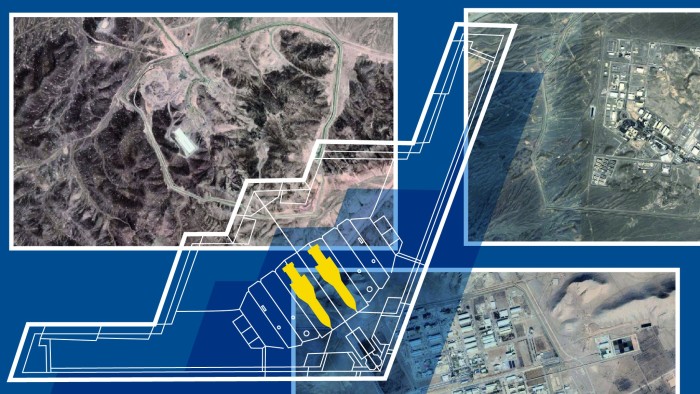Unlock the Editor’s Digest for free
Roula Khalaf, Editor of the FT, selects her favourite stories in this weekly newsletter.
The US has struck three nuclear sites in Iran in an effort to ensure the Islamic Republic is no longer able to enrich nuclear material.
The aerial assaults targeted the sprawling and sophisticated research and centrifuge arrays that Iran had built up, sometimes in secret and sometimes fully documented by international inspectors.
The extent of the damage remains unclear, but without doubt sets back decades of investment in nuclear enrichment technology. Meanwhile, Israel has already killed many of Iran’s key nuclear scientists, seeking to erase the knowledge and expertise they had gained building these plants.
It is not fully known if Iran has moved or hidden the thousands of kilos of nuclear fuel it has enriched in recent years, including about 400 kilos that international inspectors from the UN said on May 31 was near-weapons grade — around 60 per cent purity — and could be quickly enriched to above 90 per cent, the threshold required to manufacture an atomic bomb.
Fordow Fuel Enrichment Plant
The most fortified of Iran’s nuclear sites, Fordow is buried under rock and encased in reinforced concrete, designed to be safe from any of Israel’s conventional weapons.
That is why the United States had to use several of the largest weapons in it’s own arsenal, the GBU-57 E/B Massive Ordnance Penetrator, or MOP — the world’s most powerful non-nuclear bomb.
It is also the most secret — its very existence was unknown to western intelligence agencies until 2008, and made public by US President Barack Obama in 2009.
The western intelligence assessment was that Fordow’s rows of spinning centrifuges could be used to enrich the spent nuclear fuel from Iran’s peaceful nuclear energy programme to increasingly higher concentrations.
During the period of the JCPOA deal with world powers starting in 2015, Fordow was reclassified as a research facility, with regular, surprise visits from UN inspectors. Those visits continued until recently, and the IAEA assessed that Fordow was not being used for a weapons programme.
The JCPOA was an agreement with the five permanent members of the UN Security Council plus Germany that obliged Iran to keep enrichment at under four per cent, in exchange for sanctions relief.
After US President Donald Trump abandoned the JCPOA in 2018, inspectors were still allowed access, and recently documented changes to the plant’s designs that would allow significantly higher enrichment.
Natanz Enrichment Complex
The Natanz Enrichment Complex is Iran’s largest nuclear enrichment facility. Israel had attacked the site twice in recent weeks before the US assault on Saturday.
The US, along with Israel, had spent years trying to slow down Iran’s progress on enrichment technology, including a cyber attack, nicknamed “Olympic Games”, which caused the centrifuges at Natanz to slowly spin out of control. These operations held back progress for several years.
The site features thousands of underground centrifuges designed to produce various grades of enriched uranium as well as an above-ground research facility used by Iran to test new centrifuge designs. All were under full UN inspections.
Israel’s attacks earlier this week probably caused significant damage to the centrifuges, if they had been in operation at the time Israeli warplanes knocked out the electricity to the plant.
What remained was considered as formidable a challenge to destroy as Fordow — larger and more sprawling, with facilities both above and below ground. The Israeli attacks had so far only hit a few of the facilities above ground, according to the IAEA.
Isfahan Nuclear Technology Center
The oldest of Iran’s established nuclear research centres, the Isfahan site had been operational since the early-1980s. It was built in co-operation with China after the Islamic Revolution of 1979.
At least 3,000 scientists and engineers worked at the site, but there was no large-scale enrichment taking place at the facility, according to UN inspectors.
But a tranche of documents stolen by Mossad and made public in 2018, shows that until 2003, when Iran publicly shelved its formal nuclear weapons programme, scientists at Isfahan were involved in the more complex tasks of creating a feasible bomb.
There is no publicly available evidence that this research continued after 2003.
Where are Iran’s other nuclear facilities?
Iran has several other nuclear facilities spread across the country, but the largest, most crucial are the Bushehr nuclear power plant and Bandar Abbas uranium production plant.
Explosions have been reported near Bushehr in recent weeks, but it is not clear if the facility has been directly hit by Israeli warplanes. Radiation levels have not jumped, indicating that Israel may have been seeking to damage the infrastructure around the plant rather than the nuclear reactor itself.
On June 12, Mohammad Eslami, the head of Iran’s Atomic Energy Organization, said Iran had completed the construction of a third enrichment facility in a secret location.
“The new site is fully constructed and located in a secure, invulnerable location,” he said, according to the semi-official Mehr News Agency. “As soon as centrifuge installation and set-up are complete, enrichment will begin.”
Satellite map by Aditi Bhandari
Read the full article here




